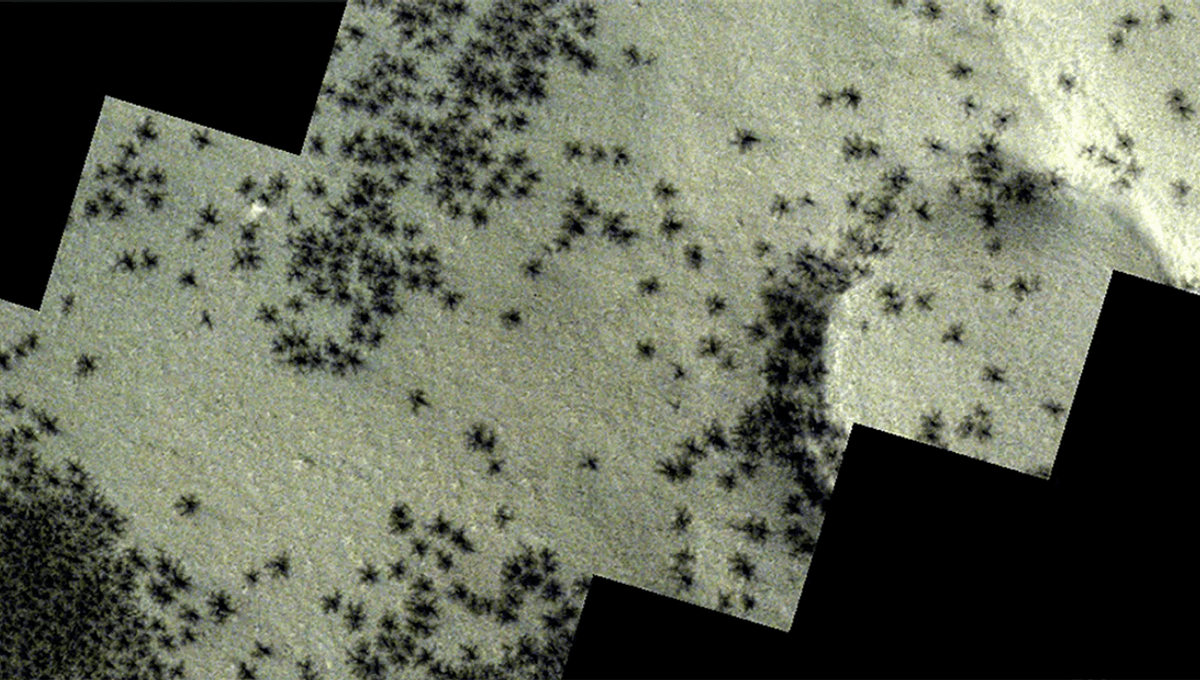
As we’ve explored the Solar System’s planets and moons using probes and orbiters, we have found and studied plenty of unusual features, from Jupiter’s “Great Blue Spot” to signs of something stirring beneath Europa’s ice.
One particularly striking feature, perhaps because it sparks our pareidolia, is the so-called “spiders on Mars“. Images taken of the southern polar region of the Red Planet show what looks uncannily like giant spiders on the planet’s surface.
Thankfully, they are not giant Martian spiders, and we have a pretty decent idea of how they form. The leading hypothesis, known as the Kieffer model after the scientist who proposed it, suggests that they are related to the heating and cooling of the planet through the seasons.
“In this model, sunlight penetrates translucent slab ice in spring and thermal-wavelength radiation gets trapped, heating the regolith beneath the ice and causing the impermeable ice slab to sublimate from its base,” a team investigating the phenomenon explains in their study.
“Through this process, spiders are proposed to be eroded via high-velocity gas scouring the sub-slab regolith, while fans and variations of spots are strewn on the ice surface, deposited by a plume of dust and gas.”
Though the Kieffer model has been widely accepted in the decades since the spiders were discovered, the team attempted to recreate the features in the laboratory, in the hopes of answering questions about whether the features are still being created today, or are a relic of a previous Martian era.
Recreating the cold, low-pressure conditions of Mars is not easy, requiring the team to use a liquid-nitrogen-cooled test chamber at NASA’s Jet Propulsion Laboratory (JPL) known as the Dirty Under-vacuum Simulation Testbed for Icy Environments (DUSTIE).
The team placed soil meant to replicate the soil found on Mars inside DUSTIE, before pumping carbon dioxide gas into the chamber to condense and form ice thick enough to perform the experiment. The ice was then heated from below, to simulate the heating mechanism thought to be at play on Mars.
After many attempts to get the ice thickness just right, the team achieved success, and lead author Lauren Mc Keown of NASA’s Jet Propulsion Laboratory in Southern California saw plumes burst out, sending the regolith flying as it did so.
“It was late on a Friday evening and the lab manager burst in after hearing me shrieking,” Mc Keown told NASA of the moment her five year quest to create such plumes came to an end. “She thought there had been an accident.”
As well as adding evidence that the Kieffer model is generally correct, the team found some surprises.
“Our plumes created crack morphologies that appeared to be driven by sublimation of interstitial ice within the regolith, rather than scouring of gas within the substrate-frost interface,” the team explains. “Overall, we conclude that the erosion by active CO2 jets might be more complex than the original Kieffer model describes, and, beyond spiders, it may contribute to formation of other typical Martian morphologies like polygonal terrains.”
The team suggests that other features such as sand furrows and active dendritic troughs could be produced by the same mechanism, though further study is needed.
The study is published in The Planetary Science Journal.
Source Link: The Infamous "Spiders On Mars" May Finally Have An Explanation